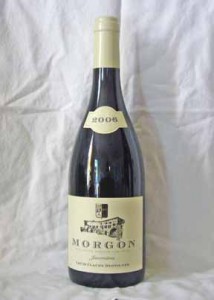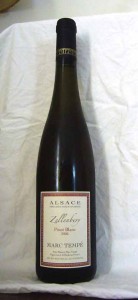Wine Picks, December 2009
Posted on December 1, 2009 – 4:13 PM | by OldManFoster Louis-Claude Desvignes, “Javernières”
Louis-Claude Desvignes, “Javernières”
Morgon 2006
58 Degrees and Holding $24.99
You know a family has been in the business of making wine for a long time if their surname means “the vines.” Indeed the Desvignes family has been making wine in Morgon – one of the ten crus, or villages, in the Beaujolais region of eastern France – for eight generations. Many of the cru Beaujolais are light-bodied wines meant to be drunk while relatively young and fresh, but Morgon produces fuller-bodied wines which benefit from a few years of bottle age. With time the wine takes on “Burgundian” qualities, which means that although its made from the fruity Gamay grape, it becomes more like earthy, woodsy Pinot Noir from Burgundy. A neologism has popped up in Beaujolais describing this process: “to pinotize.” The wines are fuller-bodied because the vineyards in Morgon have better sun exposure and soil of clay and schist. Fans of Morgon may be familiar with a hillside called Côte-du-Py where the wines are particularly dense, but Louis Claude Desvignes’s Morgon is from a plot within the Côte-du-Py called Javernières that produces fruit superior to that of neighboring vineyards. This bottle from the 2006 vintage is pleasantly austere, tasting of black currant and earth. It’s on its way toward pinotization but isn’t as silky as it eventually will be. Another year of bottle age might get it there, but if you want to drink it with your Beef Wellington this Christmas I recommend decanting (a glass pitcher will do just fine if you don’t have an actual decanter) the wine for an hour or two before the meal. As it opens up, notes of cocoa and sous-bois present themselves, and this elegant and energetic wine becomes an absolute joy.
 Marc Tempé, “Zellenberg”
Marc Tempé, “Zellenberg”
Alsace Pinot Blanc 2006
58 Degrees and Holding $24.99
There are winemakers who are steadfast in their commitment to conventionalism while others forge ahead experimentally. The French wine region of Alsace houses both ends of the spectrum and Marc Tempé would be considered one of the latter types. Conventional and experimental are relative terms however, and often the experimentalists find their way back to a truly traditional way of making wine, to what was conventional a hundred or more years ago. The grapes for Tempé’s Pinot Blanc from the village of Zellenberg are hand-harvested from old vines raised without chemical intervention and allowed to ferment with their own wild yeasts. He doesn’t add sugar or acid to the wine, additives that have unfortunately become conventional in the last half-century or so. The wine is fermented and matured in large oak foudres, traditional oval shaped casks, for a year or more (many winemakers take as little as two weeks or a few months), letting the wine remain in contact with its lees, which according to the winemaker, emphasizes the minerality and terroir of the wine. The wine is labeled Pinot Blanc but it is actually a third Auxerrois. These two grapes are often blended together because Auxerrois contributes body, richness, and aroma to the lean, crisp, and relatively neutral Pinot Blanc. The wine smells and tastes best if you let it warm up from refrigerator temperature. An earthy, refreshing and robust wine full of ginger and apple scents, it is an excellent match for any winter meal. It was spectacular with pan-fried pork chops and sage butter, but it would also be perfect with an Alsatian Christmas goose (see Jeffrey Steingarten’s recipe in It Must Have Been Something I Ate).


